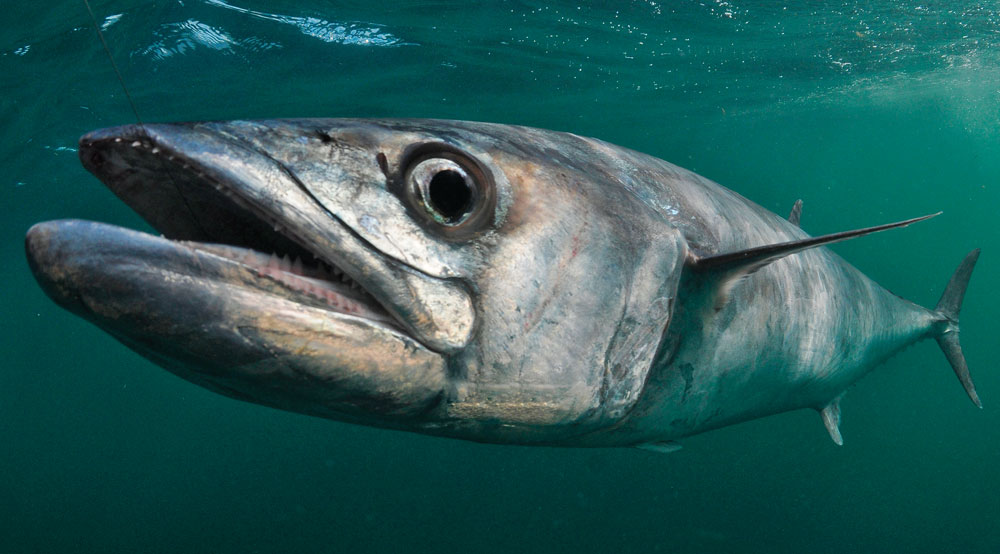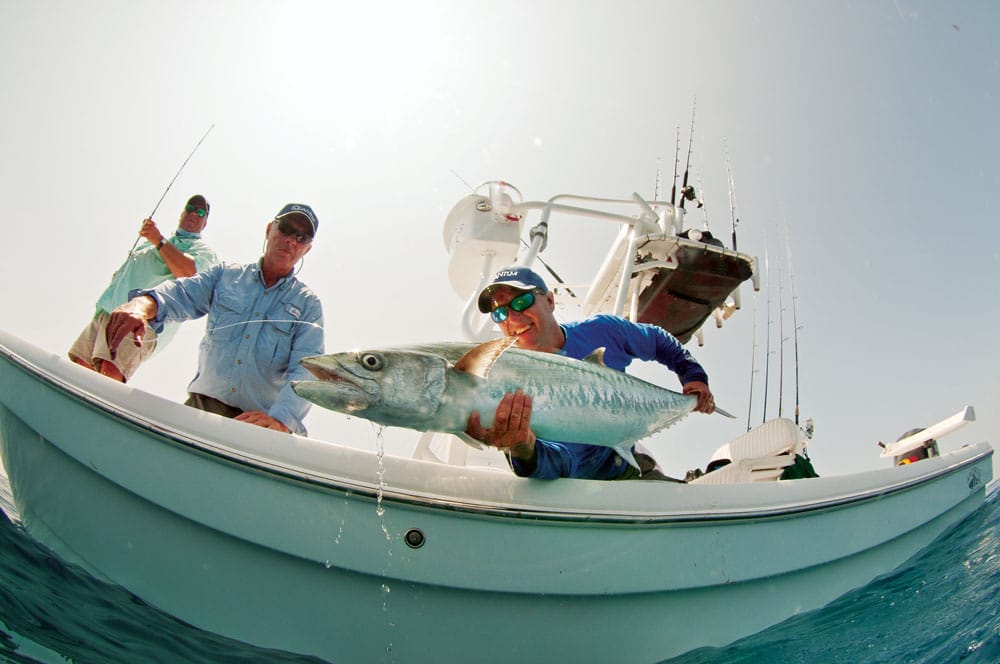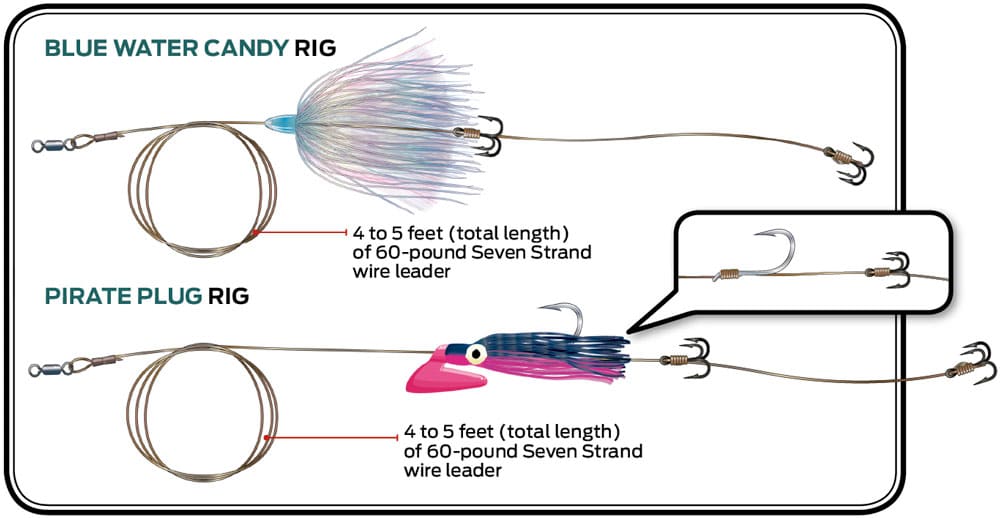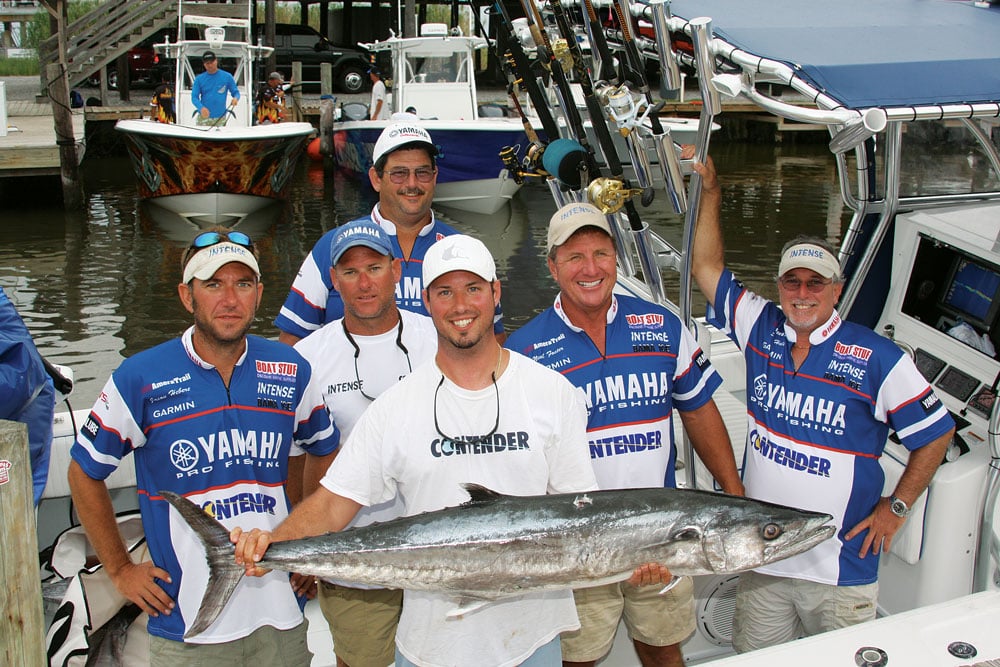
Fishing “king green” water is one key to finding and catching 50- to 60-pound smokers — the big kingfish that win tournaments.
Sometimes, just one fish can put you on top of the world. Nowhere does this ring truer than on the kingfish-tournament circuit. In these events, each team is allowed to weigh in only one king mackerel per day of competition. And so, it’s the spectacular 50- to 60-pounders known as smokers that earn the impressive jackpots, garish trophies and the singular glory that comes with winning a king mackerel fishing tournament.
Yet the path to glory is paved with more than positive thinking and a sprinkle of luck. On this highly competitive trail that ranges from the Carolinas to the Florida Keys to the coast of Texas, a one-hundredth of a pound might separate a championship team and the first-place loser (aka second place). Emotional commitment, intense preparation, financial resources, teamwork, quality equipment and strong boat-handling skills — as well as a few secret weapons — are hallmarks of the most competitive teams.
But figuring out how to catch king mackerel can be tricky. To isolate key factors to catching these wily, sharp‑toothed speedsters, we canvassed some of the leading mackerel fishing tournament anglers. While opinions on many topics varied as widely as chili recipes at a county fair, we were able to distill these 12 steps to glory.
1. The Right Boat
You can catch king mackerel from just about any boat, but the most consistent winners show up with 23- to 45-foot center-console kingfish-fishing machines from builders such as Contender, Everglades, Invincible, Intrepid, Jupiter, Regulator, SeaVee and Yellowfin.
Serious competitors have the need for speed, so most of these boats sport twin or triple outboards — some even have quads. “You want to get to the fish first,” explains Scott Smith, a North Carolina-based captain of Instigator, a 31-foot Yellowfin with twin Mercury Verado 300 outboards. “It’s not unusual for the first boat to a spot to pick off the biggest fish,” he reveals.
Power is one thing, but you also need a hull designed to run in rough conditions because the seas are not always cooperative on tournament day. “That’s why we fish a boat like the Contender 32ST,” says Jack Bracewell Jr., whose South Carolina team fishes 15 kingfish tournaments a year aboard Eren’s Addiction Too, powered by twin Mercury Verado 300 outboards. “A boat like this can take a lot of abuse, and still get us to the fish and bring us home,” he says.
2. Rig Your Boat for Success
Proper boat rigging ranks as a high priority among serious kingfish anglers. Rigging must accommodate a wide range of techniques, including downrigger-trolling, kite-fishing, slow-trolling, drifting or even anchoring, any of which might be needed, depending on the time of year or coastal region.
Catching live bait can also play a critical role, so the boat’s deck needs to be snag-free for cast-netting. Voluminous livewell capacity helps ensure the boat has enough healthy live bait to fish all day.
Finding king mackerel means having an arsenal of marine electronics to locate key structure spots such as wrecks and reef edges, as well as schools of bait. A top-quality GPS/chart plotter and fish finder are critical in this pursuit, according to leading kingfish anglers.
In addition, the most successful teams have their boats fully stocked with all the kingfish lures, kingfish rigs, leader material and terminal tackle (like live-bait hooks) they might possibly need. This allows them to quickly adapt to any feeding pattern they might find once on the fishing grounds.

3. Do Your Homework
Research represents the most critical element in king mackerel fishing. “About five days before the tournament, I start checking the Internet for fishing reports in the area,” Smith says. “Also, I keep an eye on sea-surface temperature and chlorophyll patterns on sites such as sst-offshore.com.” The idea is to find temperature breaks and the right color of water (known as “king green”) that might be holding schools of bait. Find the bait and you’ll often find the kings.
Talking to local anglers is also an important part of doing your homework, but you can’t always take them at their word, according to Smith. “The only way to confirm things is to prefish,” Smith advises. “Take the information you have, and fish the spots to make sure what other anglers are telling you is true.”
4. Kingfish Baits and Lures
Silvery live baits such pilchards, threadfin herring, menhaden, mullet and blue runners are preferable to dead baits, according to virtually all top tournament anglers. However, live bait is not always easily obtained, so these same anglers also bring frozen baits such as cigar minnows, ribbonfish and Spanish mackerel.
While opinions vary about the best bait for kingfish, there is consensus about the size of the bait for trophy kings. “The bigger kings seem to favor the bigger baits,” says Dean Panos, who runs the Double D, a 34-foot SeaVee Open on the tournament circuit. Panos is also a charter captain based in Miami.
Smith agrees. “Big baits equal big fish,” he says. Smith also has a trick for making natural baits appear even larger: He adds some “flash” to an otherwise conventional wire-leader, twin-treble bait rig. The captain uses a blue Private Stock Skirt from Blue Water Candy Lures in front of a live bait (see illustration below). The reflective material not only amplifies the size of the bait, but the shimmer —when combined with the bait’s frantic vibrations — helps attract a king’s attention at a distance.
Dead baits don’t swim, so trophy seekers often combine a swimming lure with a dead bait. One of the best kingfish lures (or bait rig setup) is the Pirate Plug from South Chathum Tackle. The lure is placed ahead of the nose-hooked bait to impart a seductive swimming action when slow-trolled. Smith has won two tournaments with this kingfish rig (see illustration below).

5. Fish a Spread
Fishing as many baits as possible helps multiply the opportunities for hookups — and the more fish you hook, the better your chances of hooking a trophy.
“I try to fish as many baits as possible,” says Smith. “We fish as many as six lines at a time, including two off the T-top 150 feet back, two others from the transom 100 feet back, and two on downriggers.”
I try to fish as many baits as possible. We fish as many as six lines at a time, including two off the T-top 150 feet back, two others from the transom 100 feet back, and two on downriggers.
— Scott Smith, Instigator
Another way to expand the spread is to fly a kite — a technique employed by many successful tournament anglers. Kites let you present baits a good distance from the boat, and this can help you entice line-shy kings to bite.
“My favorite way to fish is with a combination of three kites on one side of the boat and flat lines on the other side,” says Victor Jensen, whose South Florida team fishes the Reel Tension, a 29-foot SeaVee powered by twin Mercury Verado 300s. “Our kite baits are single-hooked, as I don’t think the bait acts naturally with more than one hook when fished on the kite.”
You can’t set and forget when fishing a spread. All of the top anglers check their baits frequently, as kings are known for nipping at baits without getting hooked. Checking the baits often helps ensure they are free of slash marks and swimming well.
6. Trolling for King Mackerel
There is much to consider when trolling for king mackerel. Trolling too fast represents one of the biggest mistakes anglers make when targeting trophy kings, according to the top tournament anglers. “Dead idle is all that’s needed when trolling live bait,” says Smith, “and sometimes that’s too fast.” On these occasions, Smith shuts down one of his twin outboards, nudging the boat along slowly with just one engine.
For some tournament anglers, any trolling speed when fishing bait is too fast. “I like to drift around oil platforms for monster kings with live baits such as blue runners, croaker or menhaden,” says Doug Stanford, who runs Pirates of the Bay charters aboard his Everglades 243 out of Port Aransas, Texas. When there’s no live bait, he drifts dead 20- to 24-inch ribbonfish with a pink hoochie skirt in front and quarter-ounce egg-sinker in the head of the hoochie.

7. Run Silent, Run Deep
Downriggers prove indispensable in the pursuit of trophy kings, yet these devices also require special rigging and a fish finder to maximize results, according to leading competitors.
One of the rigging secrets is to replace the downrigger’s wire cable with 200-pound monofilament line, a leading team captain revealed. “Using heavy mono eliminates the hum in the water that wire cable generates,” says Jensen, who believes that the twangy noise of the taut wire cable is off‑putting to big kings.
Jensen also fishes two baits per downrigger, clipping one line at the weight and another line from a second rod halfway down the line using a long-line clip. Typically, he will start out trolling one downrigger weight 60 feet down and the other weight 40 feet down, until he finds a feeding pattern.
Keeping a close eye on the fish finder helps pinpoint schools of bait, which then guides the placement of the downrigger depths. Most of the tournament competitors we interviewed try to troll the baits through or slightly above the bait schools.
8. Leave Fish to Find Fish
This advice runs against the grain for many anglers, but it makes sense when targeting trophy kings. “If you find yourself catching 15-pound kings, you probably won’t catch anything bigger in that area,” says Jensen. “Big kings don’t hang around with the small ones.”
Jensen suggests not just changing locations, but moving to a different water depth as well. “Sometimes a move shallower or deeper is the key to finding bigger fish,” he says.

9. Light Leaders
Top tournament anglers use the lightest bronze-colored wire possible, most rigging with nothing heavier than 60-pound-test Seven Strand wire or 44-pound-test single-strand “piano” wire. Wire-leader lengths range from two to five feet, and most anglers connect this with a black barrel swivel to a 20- to 30-foot top shot of 30- to 50-pound-test fluorocarbon. The main line is usually 20- to 30-pound monofilament.
10. Good Chum
Sometimes you have to put the big kings in the mood to bite, and the secret here is chum, according to a number of tournament leaders. Many big-kingfish specialists add their own secret ingredients to a stock of ground chum.
“We add chunks of sardines and bonito,” Panos reveals. “We also add glitter and menhaden oil.”
The dispersal of chum is also critical. “We ladle out one scoop of chunks at a time,” Panos reveals, “waiting until those disappear from sight before tossing out the next scoop. It’s important to keep this going, even if you have a fish hooked, as it keeps other kings in the area.”

11. Drag Settings
Every top kingfish competitor emphasizes the importance of light drag settings for landing the smokers. Most anglers use two to three pounds of drag pressure, confirmed with a scale prior to fishing.
“Once a king is hooked, it makes a remarkably fast first run,” Panos explains. “A tight drag will either break the line or pull the hook.”
Tournament anglers use a variety of reel brands and models, ranging from the Accurate Boss Extreme BX-600 to the Penn Torque TRQ30. The common denominators here include super-smooth drag systems, high-speed retrieves and plenty of line capacity.
To keep as much line on the reel as possible, most tournament anglers get aggressive with boat handling and chase down a big king, putting the angler on the bow as the captain motors toward the hooked fish.
Rods are usually custom 7-foot sticks rated for 15- to 30-pound-test line. Light tips help keep from tearing the hooks loose once you hook a big king. Keeping the rod tip high prevents the line from being tail-whipped by the big king, many top competitors advise.
Once the fight is up and down, the key is to maintain constant but light pressure while gently pumping the king to the surface. “It’s an inch game at this point,” says Smith. “A lot of tournament-winning kings have had the hooks pulled on them at this point.”
If you find yourself catching 15-pound kings, you probably won’t catch anything bigger in that area; big kings don’t hang around with the small ones.
— Victor Jensen, Reel Tension
12. Major Gaff
Most tournament anglers use a 12-foot fishing gaff with a dark nonshiny handle and a 3-inch hook, kept extremely sharp. In a typical scenario, the designated gaffer stands by the angler in the bow as the boat pursues the fish. The extraordinary length of the gaff handle allows you to reach out and gaff the king if it surfaces suddenly during the chase. The dark, nonglare finish of the handle prevents spooking the fish.
“Keep the gaff out of the water until it’s time to gaff the fish,” says Smith. “This will keep the line from getting fouled in the gaff. When it’s time, reach out and come across the back of the king to gaff him,” he advises.
No one said that catching a trophy kingfish was easy, but these 12 steps will help you set a course to glory.
Pro Tip: Don’t Waste Time
When the king mackerel are biting offshore, many top anglers forgo the traditional technique of cast-netting for bait inshore. Instead, they try to find bait closer to the kings.
“Go ahead and run offshore to where you want to fish, but make sure you take some frozen bait such as cigar minnows, Boston mackerel or Spanish mackerel,” advises top tournament angler Scott Smith, grandson of kingfish tournament pioneer Arthur Smith. “Start out fishing dead bait, but be on the lookout for schools of bait, and then use a Sabiki rig to jig up the live stuff once you find them.”








